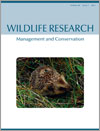Context . Understanding the ecological impacts of the palm-oil industry on native fauna requires information on anthropogenic threats that may cause species decline or local extinction.
Aim . The main aim of the study was to assess wildlife deaths caused by illegal hunting, road accidents and introduced predators in established oil-palm landscapes in Peninsular Malaysia.
Methods . Between April and October 2009, we interviewed 362 oil-palm workers at 36 sites, including large industrial estates and semi-traditional smallholdings.
Key results . Our results showed that (1) illegal hunting by oil-palm workers in different oil-palm management systems was not statistically significant (P = 0.097), (2) native fauna were more often destroyed as pests in smallholdings than in conventional and eco-friendly plantation estates (P = 0.005), (3) non-local poachers conducted illegal activity more often in smallholdings than in conventional and eco-friendly plantation estates (P = 0.011), (4) road accidents were reported to kill more native fauna in conventional plantation estates than in smallholdings and eco-friendly plantation estates (P < 0.001) and (5) feral dogs were reported as killing more native fauna in eco-friendly plantation estates than in conventional plantation estates and smallholdings (P = 0.034).
Conclusion . In addition to the conversion of native forest to oil-palm monocultures, various other anthropogenic threats can have a substantial effect on wildlife in oil-palm landscapes.
Implications . To improve the conservation value of oil-palm landscapes, we recommend that palm-oil stakeholders should implement anti-poaching patrols, organise conservation programs to educate workers, reduce vehicle speeds on roads within oil-palm landscapes, and control local populations of feral dogs.





